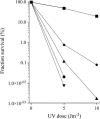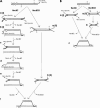Functions of multiple exonucleases are essential for cell viability, DNA repair and homologous recombination in recD mutants of Escherichia coli
- PMID: 16452142
- PMCID: PMC1456380
- DOI: 10.1534/genetics.105.052076
Functions of multiple exonucleases are essential for cell viability, DNA repair and homologous recombination in recD mutants of Escherichia coli
Abstract
Heterotrimeric RecBCD enzyme unwinds and resects a DNA duplex containing blunt double-stranded ends and directs loading of the strand-exchange protein RecA onto the unwound 3'-ending strand, thereby initiating the majority of recombination in wild-type Escherichia coli. When the enzyme lacks its RecD subunit, the resulting RecBC enzyme, active in recD mutants, is recombination proficient although it has only helicase and RecA loading activity and is not a nuclease. However, E. coli encodes for several other exonucleases that digest double-stranded and single-stranded DNA and thus might act in consort with the RecBC enzyme to efficiently promote recombination reactions. To test this hypothesis, I inactivated multiple exonucleases (i.e., exonuclease I, exonuclease X, exonuclease VII, RecJ, and SbcCD) in recD derivatives of the wild-type and nuclease-deficient recB1067 strain and assessed the ability of the resultant mutants to maintain cell viability and to promote DNA repair and homologous recombination. A complex pattern of overlapping and sometimes competing activities of multiple exonucleases in recD mutants was thus revealed. These exonucleases were shown to be essential for cell viability, DNA repair (of UV- and gamma-induced lesions), and homologous recombination (during Hfr conjugation and P1 transduction), which are dependent on the RecBC enzyme. A model for donor DNA processing in recD transconjugants and transductants was proposed.
Figures


References
-
- Anderson, D. G., and S. C. Kowalczykowski, 1997. a The recombination hot spot, Chi, is a regulatory element that switches the polarity of DNA degradation by the RecBCD enzyme. Genes Dev. 11: 571–581. - PubMed
-
- Anderson, D. G., and S. C. Kowalczykowski, 1997. b The translocating RecBCD enzyme stimulates recombination by directing RecA protein onto ssDNA in a χ-regulated manner. Cell 90: 77–86. - PubMed
-
- Anderson, D. G., J. J. Churchill and S. C. Kowalczykowski, 1997. Chi-activated RecBCD enzyme possesses 5′-3′ nucleolytic activity, but RecBC enzyme does not: evidence suggesting that the alteration induced by Chi is not simply the ejection of the RecD subunit. Genes Cells 2: 117–128. - PubMed
-
- Anderson, D. G., J. J. Churchill and S. C. Kowalczykowski, 1999. A single mutation, RecBD1080A, eliminates RecA protein loading but not Chi recognition by RecBCD enzyme. J. Biol. Chem. 274: 27139–27144. - PubMed
Publication types
MeSH terms
Substances
LinkOut - more resources
Full Text Sources
Molecular Biology Databases

